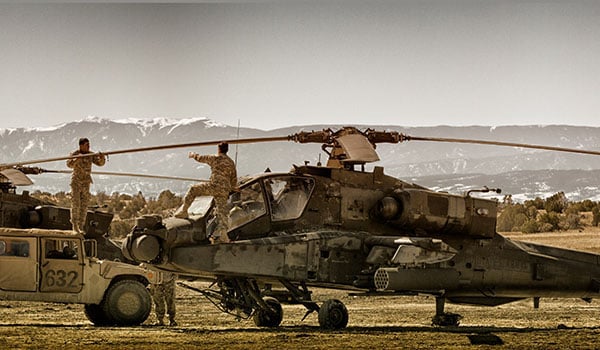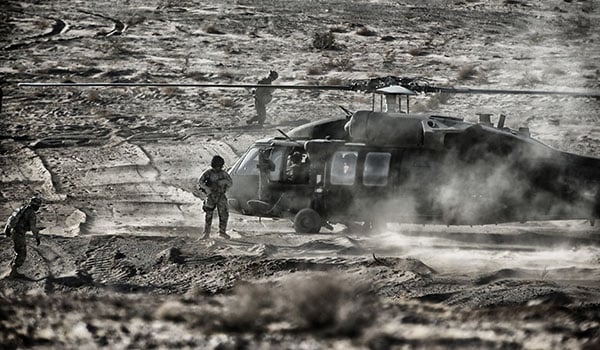
Simulation & Training / By LTC Eric Megerdoomian and numerous DES SME: The Directorate of Evaluation and Standardization (DES) is afforded a unique perspective of our branch. Through assistance and assessments of our aviation units, we are exposed to units who struggle with similar challenges and are witness to creative means to overcome them.
RCM
Leaders of Rated Crew Members (RCMs) allow improper procedures to manifest due to mission requirements. This creates a culture that accepts deviations from the standard dictated by our regulations. It is common to find organizations disregarding AR 95-1, TC 3-04.11 and their own unit Standard Operating Procedure in the execution of their Aircrew Training Program (ATP). Centralized Aviation Flight Records System (CAFRS) templates, Battalion and Brigade level oversight, and the use of the DES Individual Aircrew Training Folder (IATF) review checklist will address these shortfalls in the management of the ATP.

Maintainers with 4-4th Attack Reconnaissance Battalion prepare an AH-64D for an attack against enemy forces out of friendly contact on 13 MAR 2015 during a field training exercise at Fort Carson, CO. / ALL PHOTOS BY LTC ERIC MEGERDOOMIAN
In addition to ATP management, RCM mission proficiency is decreasing because of a disproportionate focus on base tasks over mission tasks during Readiness Level (RL) progressions. Often, this is attributed to the large number of RL progressions required with a limited number of Instructor Pilots (IPs). When executing RL progressions, Aviation Mission Survivability Officers (AMSOs) and IPs must develop tactical scenarios that employ the crawl, walk, run methodology.
After RL progression, flight schedules often fail to maximize every flight to develop pilot-in-command and air-mission-commander candidates. Annual Proficiency and Readiness Tests must be tactically focused IAW the Aviation Warfighting Initiative, TC 3-04.11, and our Aircrew Training Module (ATM) and nested in doctrine.
Range constraints and time availability is affecting our gunnery training. The TC 3-04.3 is designed to give units as much freedom as possible and encourages creativity to overcome challenges and constraints. If we utilize these products and employ our doctrine, we will greatly increase readiness, survivability and lethality.
NRCM
Leaders must take a proactive approach in assigning Flight Instructors (FIs) or Standardization Instructors (SI) or Soldiers with the “N1” Additional Skill Identifier (ASI) deliberately to mitigate standardization challenges our Non-rated Crewmembers are facing. We have observed a rapid turnover rate in enlisted NRCMs challenging nearly every unit across our branch. With promotion rates, MTOE grade-plate restrictions, and the normal career glide path of mid-grade NCOs moving out of flight companies, we are not retaining vital ACM experience where risk is greatest. This loss of experience is clearly visible during DES assessments as academic knowledge is suffering, indicated by an average written evaluation pass rate below 55%. Marginal flight performance and low FI knowledge levels are also frequently observed. In order to man the Standardization Instructor (SI) at the Battalion level, commanders are forced to send junior E5s to the Air Crewmember Standardization Instructor Course (ACSI) with just enough flight time to meet course pre-requisites and then assigning them to E6 positions at the battalion level. These SIs who are now responsible for ATP management, gunnery, and junior FI mentorship, generally do not possess the experience necessary to be successful in these positions.

A crewmember prepares to receive passengers on his UH-60 at the National Training Center on October 16, 2016. / ALL PHOTOS BY LTC ERIC MEGERDOOMIAN
ASCI at United States Army Aviation Center of Excellence (USAACE) has found that less than 40% are still executing SI responsibilities due to promotion, End of Time in Service (ETS) and accessions to the Warrant Officer corps. We have also observed a negative career stigma in the NCO corps favoring (for promotion) those who directly lead troops verse those who choose a flight centric path. This stigma leads our experienced enlisted crewmembers to pursue positions outside of the flight companies leaving these units with considerably less capability.
The problem set is being addressed by our branch, but we can take some actions to mitigate the impacts of FI/SI shortages within our units We should also consider removing self-imposed restrictions in our Standard Operating Procedures (SOPs) that prevent sending candidates to the ACSI course based on minimal utilization or PCS dates. Rather, we should understand and utilize AR 614-200, (paragraph 4-6i) which enables commanders to adjust service-remaining requirements (SSR) with HRC’s approval when Soldiers complete the ASCI TDY and Return to the unit. This allows the Soldiers to attain an assignment eligibility and availability (AEA) code of “G” giving stability under “special category” not to exceed 48 months.
Despite the great potential for change in the future, ultimately, we must find creative means to incentivize the importance of standardization for our NRCMs in the flight companies and better manage the resident experience within our formations to mitigate risk through training and standardization.
MX
Army Aviation maintenance is undergoing significant change. The development of the TC 3-04.71 Aviation Maintenance Training Program (AMTP) is the most significant which affects all units. The qualification, currency, and proficiency of enlisted maintainers has been over-looked for many years and the AMTP is a means to deliberately integrate the training of our maintainers. The .71 assists in formalizing the qualification and proficiency of our maintainers much like the ATP. Our units cannot stop maintenance and build combat power simply to focus on train maintainers. This program enables the training and qualification of our maintainers concurrent to executing maintenance tasks. Units should begin to implement the AMTP as this program will be in effect by FY21.
Parallel to the lack of a formal maintainer training program is the lack of mentorship we often observe in units. We assess the lack of mentorship is a result from two causal factors stemming from our senior warrant officers and non-commissioned officers. First, a minority of our maintainers do not understand how to execute the maintenance tasks to standard themselves making it nearly impossible for them to coach, teach, and mentor. Second, a minority of our senior maintainers do not spend the requisite time on the hangar floor or on the flight line mentoring junior Soldiers executing their tasks. Combined, our Soldiers lack the development and mentorship necessary to execute their tasks to standard resulting in a reduction of our combat power.
UAS
The most prevalent challenge concerning Unmanned Aircraft Systems (UAS) across the aviation enterprise is the full integration of UAS into the Combat Aviation Brigades (CABs) and the Heavy Attack Reconnaissance Squadrons (HARS). On assessments we observe relatively less command involvement and oversight of UAS formations than manned aircraft formations resulting in poor ATP management, maintenance, reporting, support, and training. Though typically caused by the physical dislocation of UAS units, challenges with launch / recovery sites, training areas, or off-cycle deployments, leaders at all levels should continue to strive and find creative ways to provide oversight during training.
In execution, we often find UAS crews attempting to support the units’ mission but lack the necessary security / reconnaissance guidance or tools to do so effectively. This inhibits the UAS Aircraft Commanders (ACs) ability to execute disciplined initiative and reduces the effectiveness of the crew. Use of the commander’s security or reconnaissance guidance and Information Collection (IC) are critical elements that enables ACs and transform operators into scouts.
Lastly, we often observe relatively poor standardization programs within UAS organizations. The immediate cause is a lack of proficient ATP managers largely attributed to the Instructor Operator (IO) shortages across the Army.
Given these constraints, CAB and BN commanders (much like NRCM/N1s mentioned above) can set the conditions to develop and sustain a strong ATP. First, we must forecast early the loss or movement of IOs in order to ensure timely replacements are postured to provide the necessary oversight. Second, we must commit our Standardization Pilots (SPs) of units with UAS to become intimately aware of UAS training requirements themselves, then train, mentor, and develop IOs within their formations. Finally, the SPs and commanders should provide the same level of oversight of the UAS formations and their ATPs as any other within their purview.
Summary
DES witnesses firsthand the challenges our units must face in training as we prepare to fight in large scale combat operations (LSCO) and Multi-Domain Operations (MDO). The challenges in standardization of rated and non-rated crewmembers, training of our maintenance personnel, and integration of our unmanned aerial systems operators are very real. Although Aviation Branch is working diligently on training and doctrine initiatives to build the combat power of our future forces, we must develop and employ near term innovative solutions to help lead and develop our current force. Consider the options mentioned above to mitigate these challenges at least as “A Way” of counteracting the challenges and building lethal and survivable formations able to fight and win in a complex environment.
LTC Eric Megerdoomian is the deputy director of the Directorate of Evaluation and Standardization at the United States Army Aviation Center of Excellence, Fort Rucker, AL.
Maintainers with 4-4th Attack Reconnaissance Battalion prepare an AH-64D for an attack against enemy forces out of friendly contact on 13 MAR 2015 during a field training exercise at Fort Carson, CO. / ALL PHOTOS BY LTC ERIC MEGERDOOMIAN










